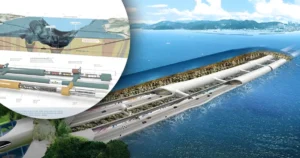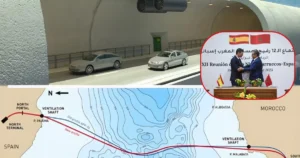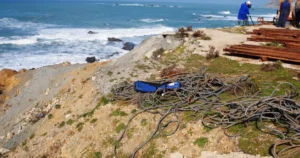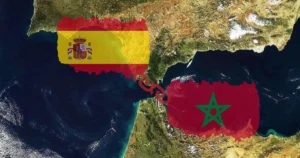
Imagine walking from Africa to Europe in a matter of minutes. What once seemed like a distant dream may soon become a reality, thanks to an ambitious engineering project that aims to construct an underwater tunnel connecting Tangier, Morocco, with Punta Paloma, Spain. This bold initiative has the potential to revolutionize transportation, trade, and tourism between the two continents.
The Spanish tunneling company Herrenknecht Ibérica has been awarded a contract to carry out a feasibility study for this historic project. Known for its expertise in drilling and tunneling, Herrenknecht has been involved in some of the largest underground construction projects worldwide. This feasibility study, set to conclude by June 2025, will determine the technical and economic viability of the tunnel before moving forward with construction.
The Vision Behind the Tunnel
The idea of linking Africa and Europe through a tunnel has been discussed for decades, but technological limitations and financial constraints have always stood in the way. However, with advancements in engineering and construction, the project is now closer to becoming a reality. The estimated cost of the tunnel is €6 billion, making it one of the most expensive infrastructure projects in the region.
If successfully completed, the tunnel will:
Drastically reduce travel time between the two continents.
Enhance trade and economic cooperation between Africa and Europe.
Promote cultural exchange and tourism.
Improve transportation efficiency by offering an alternative to ferry services.
Overcoming Engineering and Technical Challenges

While the vision is grand, constructing a tunnel beneath the Gibraltar Strait presents significant technical challenges. The strait is known for strong underwater currents, shifting tectonic plates, and complex seabed formations. Engineers will need to design a structure capable of withstanding these conditions while ensuring safety and efficiency.
Another challenge is ventilation and pressure management within the tunnel. Given its length and depth, maintaining air quality and structural integrity will require cutting-edge technology. The tunnel must also be designed to accommodate both passenger and freight transportation, further increasing its complexity.
Additionally, construction crews will face the challenge of excavating through a mix of hard rock and soft sediments. Advanced boring machines, such as those developed by Herrenknecht, will play a crucial role in cutting through the varying geological formations. The technology behind these machines will need to be customized to ensure precision, durability, and minimal disruption to the natural environment.
Economic and Geopolitical Impact

Beyond the technical aspects, this project holds immense economic and geopolitical significance. Morocco and Spain have long-standing economic ties, and a direct tunnel could strengthen trade partnerships, boost cross-border investments, and enhance labor mobility.
For Europe, the tunnel would provide easier access to Africa’s growing markets, creating new business opportunities and trade routes. Meanwhile, for Morocco and North Africa, this project could accelerate economic development by facilitating exports and tourism.
From a geopolitical perspective, the tunnel would symbolize strengthened diplomatic relations between Morocco, Spain, and the European Union. However, political challenges could arise regarding regulations, border control, and financing. Ensuring strong diplomatic cooperation will be essential for the project’s viability.
Environmental Considerations and Sustainability

Like any large-scale infrastructure project, the Morocco-Spain tunnel raises environmental concerns. The construction process could impact marine life, water currents, and coastal ecosystems. Environmental experts must assess potential risks and develop mitigation strategies to minimize ecological disruption.
Furthermore, ensuring the tunnel’s sustainability is key. Integrating renewable energy sources, optimizing materials for durability, and adopting eco-friendly construction practices can help reduce the project’s environmental footprint.
An additional concern is the tunnel’s carbon footprint. While it will reduce emissions from ferry travel, the operation of a massive underground transport system requires energy-efficient solutions. Using green energy sources, such as solar and wind power, to support the tunnel’s operations could make it an environmentally responsible project.
The Future of Transportation: How This Tunnel Compares to Other Megaprojects
If completed, the Morocco-Spain tunnel will join the ranks of other monumental underground transportation projects, such as:
The Channel Tunnel (UK-France): Spanning 50.5 km, this underwater tunnel connects England and France beneath the English Channel.
The Seikan Tunnel (Japan): At 53.85 km, it is the world’s longest undersea tunnel, connecting Japan’s Honshu and Hokkaido islands.
The Gotthard Base Tunnel (Switzerland): The longest railway tunnel in the world at 57 km, passing through the Swiss Alps.
Each of these projects faced immense challenges in design, funding, and execution but ultimately transformed transportation and commerce. The Morocco-Spain tunnel has the potential to match these achievements by opening new economic and travel opportunities between Africa and Europe.
A Step Towards a More Connected Future

If successfully implemented, the Morocco-Spain tunnel would stand as a landmark achievement in engineering and international cooperation. It would bridge continents, foster economic growth, and bring people closer together like never before.
While many challenges lie ahead, the progress of Herrenknecht Ibérica’s feasibility study will determine the next steps for this visionary project. If all goes as planned, we could witness the completion of one of the world’s most ambitious infrastructure endeavors within our lifetime.





